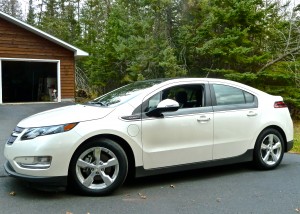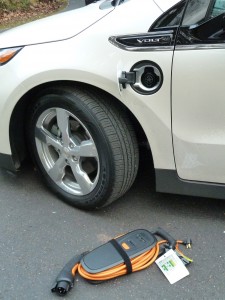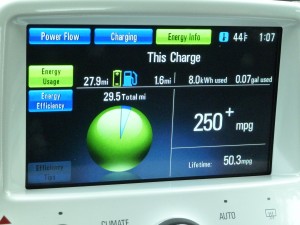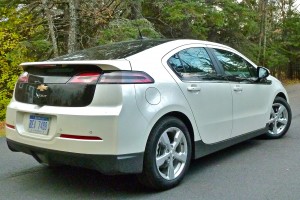Volt loses volts as weather chills out
By John Gilbert
The morning after I inadvertently left my pocket camera in the car outside overnight, when it was 10-below zero, I spotted the camera and turned it on, and a little red light flashed to warn me that my fully-charged battery was down to zero. I slid the camera into an inside pocket of my down parka, and went on my way.
A couple of hours later, I turned on the camera again, and — as if by magic — found that my body heat had rejuvenated the battery to full status. I was impressed at its powers of recovery, and immediately, I wondered what would happen to the battery pack in a Chevrolet Volt in the same weather.
I had been test-driving a Chevrolet Volt a few weeks earlier, when it seemed as though we were going to have a winter with no snow or cold in Northern Minnesota. The Volt, of course, is Chevy’s impressive experiment at making a plug-in electric car, with a separate gas-engine for backup. I wondered how severe cold might reduce the Volt’s battery-powered drive from its 50-mile range.
The comparatively winterless winter has seemed strange in Northern Minnesota, because even the occasional snowstorms that have hit Minneapolis and most of Wisconsin haven’t reached as far as the tip of Lake Superior. In fact, this year’s John Beargrease Dogsled Marathon from Duluth up the North Shore and back has been cancelled because of a lack of snow. A dogsled is about the only vehicle that gets more “miles per gallon†than a Volt, or a Nissan Leaf, which runs pure electric power.
We did have a couple of normally frigid cold-snaps to contend with, between curiously warm, 30 and 40-ish temperatures. It was during one of those chilly weeks when we had a glistening white Volt — the first electric vehicle I’ve been able to run through my normal test-drive routine. While normal Minnesotans are hardy enough to endure the worst winter can provide, I actually look forward to extremes of cold weather, snowfalls, and even ice-covered streets, in order to better test how new vehicles handle adverse circumstances.
Our family routine for each week-long road test is to drive normally for a couple of days in the Minneapolis area, then drive the sustained 165 miles north to Duluth, where we spend three days or so driving around on Duluth’s scenic hills, and then back to Minneapolis. We had two cars that week, so my wife, Joan, and set out a day ahead of me, in the Volt.
She parked the Volt in our garage, and plugged it in. Next morning, she called and said that she wondered if it was all worth it. “It was plugged in all night, and when I unplugged it and drove out, it said the car was fully charged, but was limited to 33 miles of electric range,†she said.
Next day, I repeated the process. We drove the Volt 10 miles downtown, and around, and back home. Probably 40 or 45 miles. I drove it into the garage, uncoiled the cable from the trunk, plugged it into the car’s left flank outlet, and into the normal wall socket inside the garage.
It was 20 degrees above zero when I unplugged the Volt the next morning. It said, “Fully charged.†It also said I’d have a 33-mile limit to electric-drive range. I backed out of the garage, about 35 feet, then got out to close the garage door. When I climbed back into the Volt, the gauge said my remaining range was 32 miles. I had used one mile up by backing out of the garage. We drove to the end of the driveway, and the range had gone down to 31 miles. In our first block, we used up two miles of electric range?
One of the features of the Volt is that if you watch the gauges closely you can see when your electrical power is running down, and figure out when it makes the transition to gas-engine power. Otherwise, you can’t feel a thing when the battery-pack’s juice runs out and the car switches to gas-engine power. So I wasn’t sure if I got my “full†30 miles out of the battery’s charge, which was reduced by at least 10 from its warm-weather maximum by the chilly, 20-above, weather.
That’s why the comparison to the battery in my little Lumix camera came to mind. Wouldn’t it be great if, after severe cold lessens the range of an electric car, it might be “warmed up†to rejuvenate its electrical supply?
For car-buyers who drive 10 miles to work and 10 miles back, or less, the Volt would be an intriguing purchase, because you could charge it fully overnight at home, and make it to work and back home without ever using a drop of gasoline for the accompanying 1.4-liter, 4-cylinder gas engine. The nice part is that if you did have to go farther, for an emergency, or if you’re out of orange juice, the gas engine kicks in like a safety net to get you where you’re going.
For anyone who might want to drive as far as Minneapolis to Duluth, or back, on a fairly regular basis, the Volt becomes more questionable. You can get about 35-38 miles per gallon overall, which isn’t bad, but that includes getting the first 33 free, on electric power, and barely 30 mpg for a combined 150-mile trip from Duluth to Minneapolis.
The Volt is enjoyable to drive, accelerating swiftly to highway speed with a combined 149 horsepower and 273 foot-pounds of torque, fed through a continuously variable transmission. Its comparatively heavy frame feels well-planted, and the suspension offers a firm stability in cornering. Electric power steering works well, even if the steering feedback feel is a little vague. The interior amenities are impressive. Nice instrument layout, and well-done specialty instruments that you can summon with the right switches to monitor whatever you might want to check on.
For example, starting out with a full charge and taking it easy, I drove 29.5 miles before noticing the system had shifted from electric to gas. I clicked on the right page, and it showed that of the 29.5 miles, 27.9 of them had been all-electric — what happened to my 31? — and only 1.6 miles on the gas engine. That meant I had used all the stored electrical energy, and 0.07 gallons of gasoline. The computer read all that to indicate “250+†miles per gallon if you apportioned the 0.07 gallons over 30 miles.
Very impressive. Even if driving 120 miles more lowered that computerized total average to 37.5 mpg.
Decent interior room and trunk space make the Volt a worthy family car, but it comes back again to whether you want to pay the $40,000-range price for a compact sedan that gets 37 mpg anytime you want to venture beyond the electric range of 40 miles. Or, 33; or 29.5.
“I like everything about the Volt,†said Joan. “It looks good on the outside, and the interior is very nice. The seats are good and the power and handling are good enough.
“But I’m afraid I would find it more convenient to just drive it like a normal car, without the inconvenience of plugging it in. When you’re going to drive 165 miles, it almost doesn’t seem worth it to plug it in all night and pay whatever that works out to be for electricity, for only 33 miles. I’d probably get in the habit of driving it and liking it as a normal little car, without going to the trouble of plugging it in every night.â€
That, of course, defeats the purpose of spending extra money for a Volt, even with a government kickback to reduce the $40,000 sticker by $7,500. There are a number of lighter and more agile sedans on the market that will deliver 35-40 mpg for half that price.
Our test week was concluded before the government crash-testing issue with the Volt arose. It seems that when the crashed cars were left, a Volt caught fire. There have been other Volt fires, apparently traced to the electrical plug-in system, or to damage of the electrical system from the controlled crashes. Further tests haven’t disclosed any apparent evidence about why those fires occurred.
One of the main features of the Volt when it was introduced was that Chevrolet stressed it was not a hybrid. Even though it has a gasoline engine, that engine is only used to move the Volt after the electrical power has been depleted. A hybrid, in contrast, runs on power from electric motors that are recharged by a generator run by the onboard gasoline engine. When stepped on hard, the gas engine power can supplement the electric power, but the basis for the system is that the gas engine recharges the battery pack for what is, in essence, free power.
It seems it would be the ultimate irony if the easiest fix for the Volt’s potential electrical fires might be to alter the combination engine/motor to convert it into a hybrid. Interesting idea, because going 33-40 miles on “free†electric power and then switching to the 30-something of the gas engine is less enticing to me than a vehicle that runs on and electric-power range that can be extended by being recharged with free power from the gas engine.
With virtually every manufacturer in the world introducing or working on electric cars, an interesting comparison arose out of the first year of the Volt, which was accompanied in time by the Nissan Leaf, a pure-electric vehicle with a range of 100 miles on a full charge and with no gas engine for backup. Both, in fact, were introduced to the media in the same week.
In their first year on the market, with both companies trying to expand the regions where they first sold their electric cars, Motor Trend reported that through October, 5,003 Volts were sold, compared to 8,066 Leafs (Leaves?) — even though Nissan has spent far less on marketing and advertising for the Leaf. It would appear that those who live close enough to work, or wherever their daily driving takes them, might find the Volt appealing, and the Leaf possibly a better alternative, with its lower price of $34,000 before incentive rebates, to the Volt’s $39,995, plus much greater range of 100 miles to 40 for the Volt.
I’ve driven the Leaf, but only at the car’s introduction, where it showed surprisingly good performance — zooming silently up to and over 90 miles per hour with my co-driver at the helm. I haven’t gotten one for a week’s test of my own yet. One of the reasons might be that it would require being trucked up from the press fleet in Chicago to Minnesota, or else face four long layovers for recharging.
For my personal test, I would have to alter my norm, or else drive the car for a couple of days around Minneapolis, then head for Duluth, stopping two times for several hours each for recharging — a long, long lunch, perhaps? — before making it to Duluth on three full charges.
As far as my family is concerned, hybrids make a lot more efficient and economic sense. Impressive as everything is about driving the Volt, when Chevrolet introduced it, the Chevy PR machine stressed: “This is not a science project.†A year later, it occurs to me, that’s exactly what the Volt is.
Having already witnessed the dropoff in electric battery power when it is down to 20 degrees above, the drop in mileage range might be considerably more severe when it goes to 10 or 15 below zero, even if you keep your Volt in a garage, preferably a heated garage, every night, and also keep it indoors at work.
Last time I checked, even if warming the car up like I did my camera were possible, Eddie Bauer doesn’t make a down jacket big enough to cover a Volt.
Comments
Tell me what you're thinking...
and oh, if you want a pic to show with your comment, go get a gravatar!






 John Gilbert is a lifetime Minnesotan and career journalist, specializing in cars and sports during and since spending 30 years at the Minneapolis Tribune, now the Star Tribune. More recently, he has continued translating the high-tech world of autos and sharing his passionate insights as a freelance writer/photographer/broadcaster. A member of the prestigious North American Car and Truck of the Year jury since 1993. John can be heard Monday-Friday from 9-11am on 610 KDAL(www.kdal610.com) on the "John Gilbert Show," and writes a column in the Duluth Reader.
John Gilbert is a lifetime Minnesotan and career journalist, specializing in cars and sports during and since spending 30 years at the Minneapolis Tribune, now the Star Tribune. More recently, he has continued translating the high-tech world of autos and sharing his passionate insights as a freelance writer/photographer/broadcaster. A member of the prestigious North American Car and Truck of the Year jury since 1993. John can be heard Monday-Friday from 9-11am on 610 KDAL(www.kdal610.com) on the "John Gilbert Show," and writes a column in the Duluth Reader.